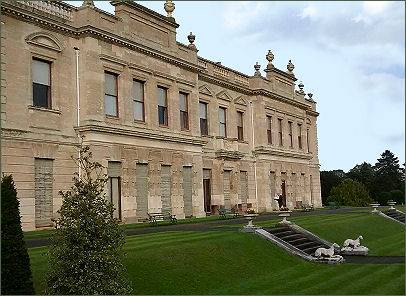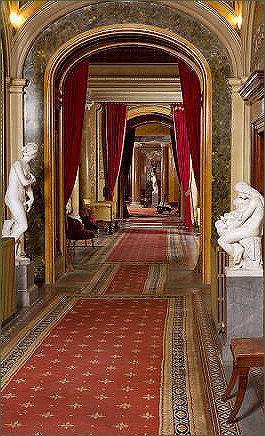Brodsworth Hall
OS grid reference:- SE 506 071
 Brodsworth Hall is situated 5 miles to the north west of Doncaster in South Yorkshire and is one of the most complete surviving examples of a Victorian country house in England.
Brodsworth Hall is situated 5 miles to the north west of Doncaster in South Yorkshire and is one of the most complete surviving examples of a Victorian country house in England.
Its opulent interior and upstairs-downstairs lifestyle was preserved almost by accident when spiraling costs and lack of staff after World War I meant that parts of the house were simply closed off and time stood still.
 George Henry Hay, 8th Earl of Kinnoull purchased the Brodsworth estate from Sir John Wentworth in 1713 and rebuilt the house. His younger son Robert took up residence on the estate when he was made Archbishop of York in 1761 and made a number of improvements to both the house and grounds. On his death in 1777 the house was left empty and when his eldest son sold the estate in 1790 to Peter Thellusson (1737-1797).
George Henry Hay, 8th Earl of Kinnoull purchased the Brodsworth estate from Sir John Wentworth in 1713 and rebuilt the house. His younger son Robert took up residence on the estate when he was made Archbishop of York in 1761 and made a number of improvements to both the house and grounds. On his death in 1777 the house was left empty and when his eldest son sold the estate in 1790 to Peter Thellusson (1737-1797).
Peter Thellusson had settled in England from Europe and became a director of the Bank of England and a wealthy tobacco and sugar importer. He left an unusual will, whereby his fortune was put in trust to be untouched for three generations. This was unsuccessfully challenged by his family in the Thellusson Will Case, One of the eventual two eventual beneficiaries was his great-grandson Charles Sabine Augustus Thellusson who inherited the Brodsworth estate in 1859.
The Italianate style house which occupies the site today was designed by the London architect Philip Wilkinson for Charles Sabine Augustus Thellusson and is virtually unchanged since the 1860s. the design may have been influenced by Osborne House, Queen Victoria's Italianate mansion on the Isle of Wight.
Brodsworth Hall has more than 30 rooms, containing collections of eighteenth and nineteenth century European paintings and eighteenth century furniture, ranging from grand reception rooms with original furnishings to the servants' quarters. White marble statues, which begin in the grand entrance hall, continue to the South Hall and include the beautiful Sleeping Venus by Argenti. Grand salons are painted throughout in a faux marble effect. The Drawing Room features Corinthian columns and a painted ceiling, with gilded decoration including floral symbols, birds, amd arabesque ornaments.
Charles Sabine and his wife Georgiana left four sons, all of whom died childless. On the death of the youngest son the house passed to his nephew Captain Grant-Dalton in around 1930. The house was acquired by English Heritage in 1990.
The house is surrounded by six hectares of Victorian period gardens, which were laid out at the same time the house was built and are designed in the Italiante style, featuring a fern dell, rose garden with a restored summerhouse in the classical style. From the summerhouse, views are afforded into the romantic quarry garden, with its paths, bridges, and vistas. The centrepiece is a restored Dolphin Fountain. The gardens are used for special events throughout the summer. There is a free car park on the grounds and an overflow nearby.
